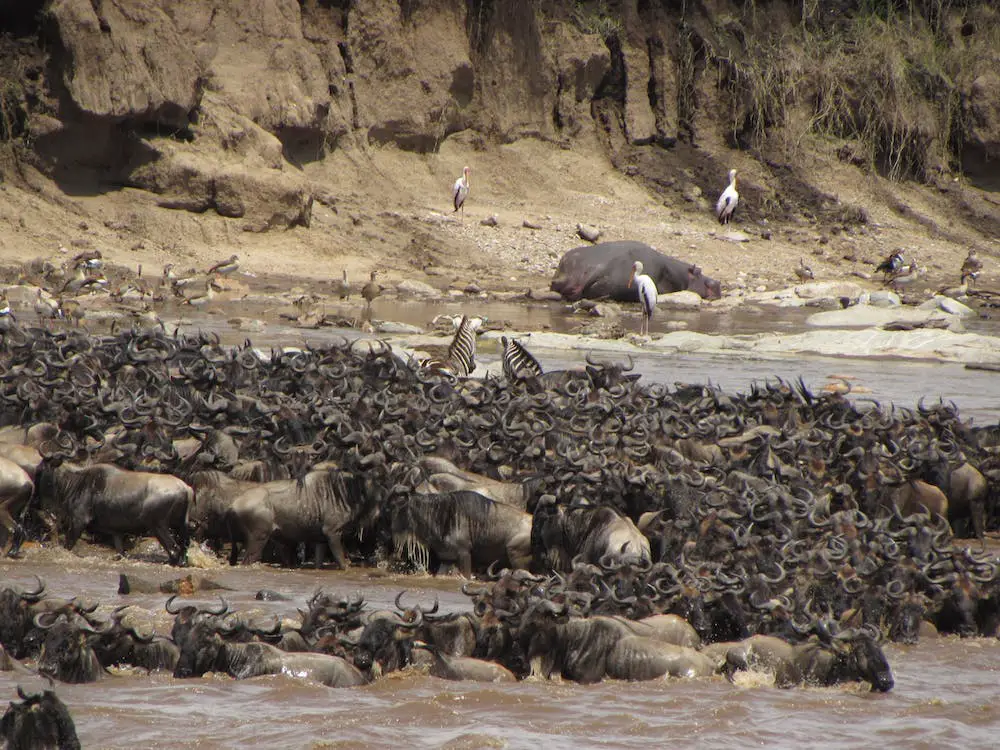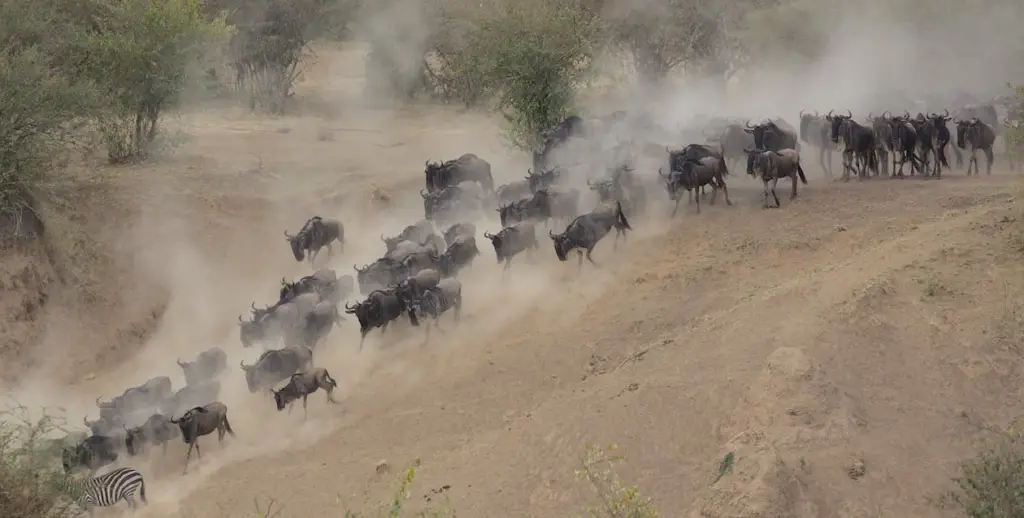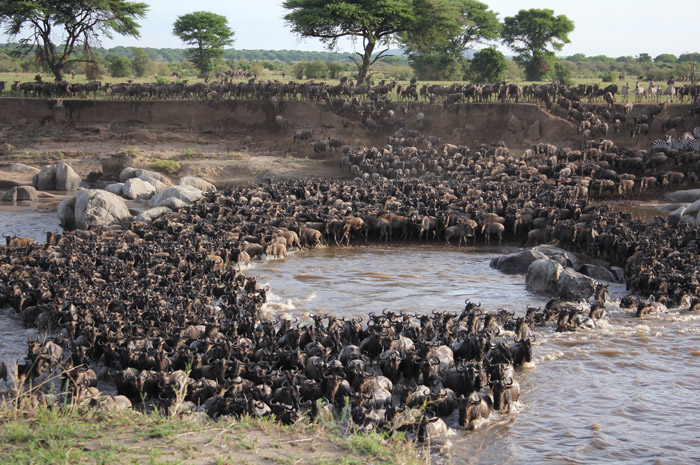The Masai Mara wildebeest migration is one of the most sought-after phenomena for wildlife enthusiasts. Considered one of the wonders of the world, the wildebeest migration is one of the world’s most spectacular displays of wildlife behaviour. This is the largest herd movement of animals across the planet, a count of 1000 animals per km2 and is visible from space.

What is the Wildebeest Migration?
The wildebeest migration is the migration of animals across the Serengeti – Mara ecosystem. The migration takes place every year where the animal primal instincts guide them towards greener pastures following rainfall patterns over the Serengeti and Mara. Unknown to most people, the great migration involves other animals besides the wildebeest such as Zebras, Eland, Grants and the Thompsons gazelles.
What Month Does the Wildebeest Migration Happen?
Whilst most people think the wildebeest migration happens once between July and October, this natural phenomenon takes place all year round. The migration is popular between July and October because it’s this time that animals cross the Mara river and coincides with the peak season. The crossings occur at the Mara river around July to September and from mid-October to early November as they return to the south.
Here is a breakdown of where the herds are during different times of the year. The animal movement is usually prompted by rain which could be early, late or on time.
December to April
The best place to see the wildebeest migration in this period would be south of the Serengeti National Park between the Ndutu plains and Ngorongoro plains. The calving season begins in February so you’re assured of witnessing the wildebeest calving. The calving season also attracts predators such as lions, hyenas, cheetahs and leopards who prey on the young calves. Towards the end of March to early April, the animals begin their journey North towards the Masai Mara.

May to June
During this time of the year, the animals move northwards in search of pasture and water. The herd consists of large numbers of wildebeest often in millions and hundreds of thousands of zebras, Grants and Thompsons gazelles. During this period, the animals are crossing the Grumeti River which is infested with Nile crocodiles. Whilst there is some wild action as the crocodiles catch the slower-moving animals, the scene is not as spectacular as the Mara River crossing.
July to September
From July, the animal herds have reached the Grumeti reserve and the Western Serengeti. In August, the surviving herds continue to move northwards towards the northern Serengeti into the Masai Mara reserve. At this time, the animals split into smaller groups where a greater number have already crossed over to the Mara reserve.
The Mara River crossing is always the highlight of the wildebeest migration as tourists are treated to spectacular views as the frantic herd wades through the murky, crocodile-infested waters of the Mara River.
October to November
The wildebeest migration from Masai Mara to the Serengeti national park starts again in mid-October. The herds move from northern Serengeti to Lobo and Mbuzi Mawe regions where there are greener pastures and water. The calving season begins again as the predators prey on the young and vulnerable calves.
Where Does the migration Start and End?
The scene of this astounding spectacle is the Greater Serengeti – Mara ecosystem which covers both Kenya and Tanzania. The herd mostly consists of approximately 1.2 million wildebeests and hundreds of thousands of elands, zebras and gazelles. These animals trek 1800 miles clockwise in a circle through the Serengeti and Mara Eco-system in search of food and water.
How Many Animals Migrate and Why Do They Migrate?
The Masai Mara migration is mainly triggered by the rains as the animals move in search of greener pastures. Over 2 million wildebeest, zebras, gazelles and other animals migrate from the southern part of the Serengeti national park into the Masai Mara national reserve. The majority of the animals are wildebeest however, there is also a large number of zebras and gazelles.
When Is the Best Time to Go in order to Experience the Migration?
The wildebeest migration mainly relies on the availability of pasture and water which is determined by rainfall patterns. Whilst rainfall patterns are not accurate and it would be difficult to predict animal movement, there is a general rule to the flow. Normally, the herds begin to head north from the Serengeti in early May and reach the Masai Mara in late July. From mimid-Augusto September, the herd will begin to cross into Masai Mara where it spends some time before moving back south from November through to December.
What to Expect During the Migration
The Mara river crossing is the highlight of the Masai Mara wildebeest migration. The river is home to over 3,000 nile crocodiles and it’s always a spectacle during the crossing as the crocodiles seize their prey with their powerful bite. These crocodiles are large, measuring up to 14 feet long and use their tail to help them grasp their prey. Once they bite and drown their prey, they twist and break them into bite-sized chunks.
As the drama unfolds in the river, predators such as lions, cheetahs and hyenas on ground trying to catch the vulnerable herbivores. It’s advisable to bring a pair of binoculars to get a better view of the action as the safari vehicles are usually parked a few metres from the banks of the Mara river.
Where to Stay to Experience the Migration
The Masai Mara reserve offers a hosts of viewing options from luxury accommodation, mid range lodges to budget tented camps. Most of the hotels located on the migratory route are luxurious lodges. Here is a round up of the best places to stay during the wildebeest migration.
- Royal Mara Safari Lodge
- Kichwa Tembo Camp
- Little Governor’s camp
- Mara Serena Safari Lodge
- Kicheche Mara Camp
- Serian Nkorombo
- Rekero Camp
- Mara Ngeche Safari Camp
- Entim Mara

How Much Does it Cost to See the Migration?
A Masai Mara trip can be very expensive. It’s impossible to give a fixed cost because there are various factors that determine the cost of your Masai Mara safari. Some of these factors include; time of the year, number of people travelling, mode of transport, type of accommodation, duration of your trip and other activities. Let us look into each factor in detail.
Accommodation
Your choice of accommodation contributes largely to the overall cost of your trip. There are different lodges that cater to every budget. If you’re looking to miminise the cost of your Masai Mara trip, you can opt for budget safari camps located just outside the reserve.
A luxurious tented camp such as Kichwa Tembo could cost roughly $550 per night. A mid range safari camp such as Keekorok could cost about $200 per night while a budget camp could cost roughly less than $100 per night. These are low-season costs and are likely to increase during the high season.
Number of People Travelling
Most of the safari camp and lodges in the Masai Mara have discounted rates for group travellers. This is cheaper as you get to split the costs. Some safari lodges have discounted rates for younger children and in some cases children under 3 years stay for free.
Mode of Transport
The mode of transport is one of the major costs in your Masai Mara trip. Travelling from Nairobi city to Masai Mara is usually cheaper by road compared to flying but the journey may take up to 4 hours. If you’re travelling solo, it makes more sense to fly as it would be cheaper and more convenient.
Duration of Your Safari
The cost of your Masai Mara trip is also dependent on the number of days you plan to be on safari. If you are on a budget, it’s best to stick to a 3 day safari. Contact your safari operator to find out the best time to see the wildebeest migration so you are able to plan accordingly.
Time of the Year
The time of the year also determines the cost of your Masai Mara trip. Generally, rates tend to be higher during the peak season which usually runs from July to October. The low season runs from January to March where accommodation is more affordable and the park is not overcrowded.
Is the Wildebeest Migration Worth it?
This natural phenomenon is one of the wonders of the world that only happens in the East African region. The wildebeest migration is a sight to behold,picture a vast land filled with grunting, rutting and groaning of millions of animals sprinting and pushing along the banks of a river. With so many animals hurdled together, it attracts predators who prey on the young and vulnerable herbivores, this is an exciting time for some wildlife action as you watch the animals hunt.

